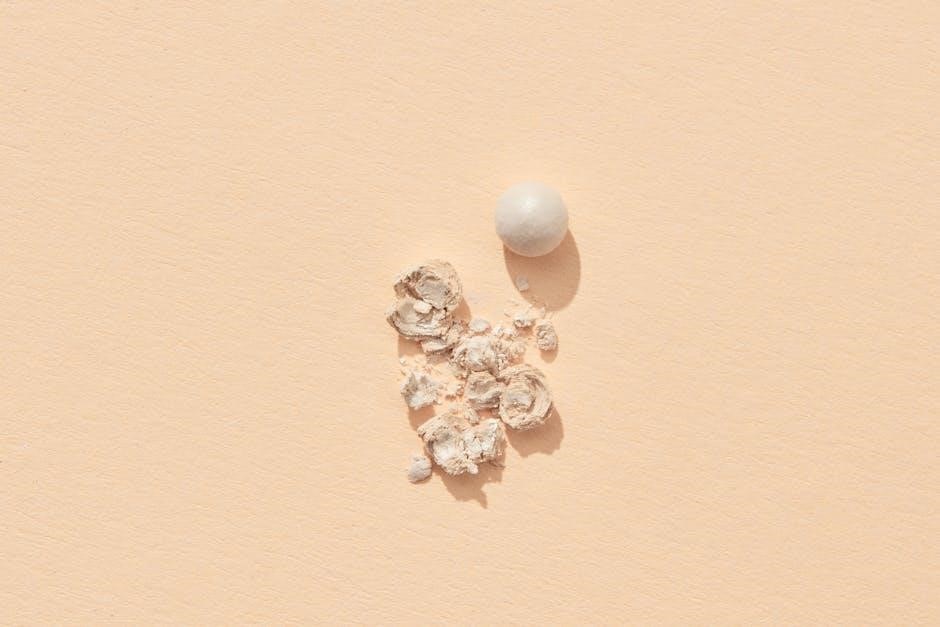Ear stretching is a gradual process of enlarging pierced earlobes to accommodate larger jewelry, offering a unique form of self-expression. It requires patience, safety, and proper aftercare to ensure healthy results.
What is Ear Stretching?
Ear stretching, also known as earlobe stretching, is a body modification practice that involves gradually enlarging a pierced hole in the earlobe. This process allows individuals to wear larger jewelry, such as plugs, tunnels, or gauges. The method typically involves using tapers or stretching tools to slowly increase the size of the piercing over time. It is important to use high-quality, biocompatible materials, like glass or metal, to minimize risks. Ear stretching is a personal choice often associated with cultural or aesthetic expression. Unlike standard piercings, stretched ears require careful maintenance to ensure the skin remains healthy and intact. Proper technique and patience are essential for achieving desired results safely.
Benefits and Considerations of Ear Stretching
Ear stretching offers a unique form of self-expression and aesthetic appeal, allowing individuals to showcase personal style through various jewelry options. It can enhance cultural or spiritual identity for some. However, it’s important to weigh the benefits against potential considerations. Proper stretching requires patience and dedication to avoid complications like infections or tears. The process is irreversible without surgical intervention, so careful planning is essential. While the results can be visually striking, improper techniques or rushing the process may lead to discomfort or long-term damage; Understanding the commitment and risks involved is crucial before starting your ear-stretching journey.
Step-by-Step Guide to Stretching Ears
This guide outlines a safe approach to ear stretching, covering essential steps like preparation, choosing tools, cleaning, lubricating, and aftercare to ensure healthy results.
Step 1: Preparing for the Stretch
Before stretching, ensure your piercing is fully healed to avoid complications. Wash your hands thoroughly with antibacterial soap and clean the area. Timing is crucial—stretch after a warm shower when your skin is soft. Use a lubricant like jojoba oil to ease the process. Avoid stretching if your ears are irritated or inflamed. If you’ve recently stretched, wait at least 8 weeks before proceeding; Start with smaller gauges and gradually increase to prevent tearing. If you experience discomfort or swelling, consider downsizing temporarily. Patience is key to maintaining healthy, intact skin during the stretching journey.
Step 2: Choosing the Right Size and Tools
Selecting the right tools and size is essential for safe ear stretching. Start with a smaller gauge and gradually increase to avoid overstretching. Use high-quality materials like glass, stainless steel, or titanium for jewelry and tapers. Lubricants such as jojoba oil or coconut oil can ease the process. Choose tools that fit your current piercing size and desired outcome. Avoid using improper objects, as they may cause damage or infections. Consider the thickness of your earlobe and stretch slowly to maintain healthy skin integrity. Always opt for sterile or sanitized equipment to minimize risks. Properly sized tools ensure a smooth and safer stretching experience, reducing the likelihood of complications.

Step 3: Cleaning and Lubricating
Cleaning and lubricating are crucial for a safe and comfortable ear-stretching process. Begin by washing your hands and ears with mild soap and warm water. Use a saline solution to gently clean the area, avoiding harsh chemicals like alcohol or hydrogen peroxide. Lubrication is key to reducing friction and discomfort; natural oils such as jojoba or coconut oil are ideal. Apply a small amount to the taper and earlobe before stretching. Regular massaging with oil after a warm shower can also promote healthy skin elasticity and ease any tightness. Keep the area clean and moisturized to prevent irritation and support the stretching process effectively.
Step 4: The Stretching Process
The actual stretching process should be done slowly and carefully to avoid discomfort or damage. Start by ensuring your earlobe is well-lubricated with a natural oil like coconut or jojoba oil. Insert the taper gently, aligning it with your existing piercing. Apply steady, gentle pressure, allowing the skin to stretch gradually; Avoid forcing the taper, as this can cause tears or irritation. If resistance is felt, stop and wait a few days before attempting again. Stretching should be done after a warm shower when the skin is soft and pliable. Monitor the size and stop when you reach your desired gauge. Patience is key to achieving a healthy, even stretch without causing harm to your ears.
Step 5: Aftercare Routine
A proper aftercare routine is essential for maintaining healthy, stretched ears. Clean the area twice daily using a saline solution or mild soap and warm water. Avoid harsh chemicals like alcohol or hydrogen peroxide, as they can irritate the skin. Gently pat the area dry with a clean towel to prevent moisture buildup, which can lead to infections. Monitor for signs of redness, swelling, or discharge, which may indicate a problem. Massaging your lobes with a natural oil, such as coconut or jojoba oil, after a warm shower can promote healing and flexibility. Keep jewelry clean and avoid touching the ears unnecessarily to reduce the risk of contamination. Consistent care ensures your stretched ears remain healthy and comfortable.
Step 6: Knowing When to Stop
Recognizing when to stop stretching is crucial to avoid overstretching or causing permanent damage. Listen to your body—discomfort, pain, or swelling are signs to pause. Set clear goals for your desired size and resist the urge to push too far too quickly. Patience is key; stretching too aggressively can lead to tears or irreversible harm. If you notice persistent redness, swelling, or discharge, it’s a signal to stop and allow your ears to heal. Consulting a professional can help determine the right time to stop. If you’ve reached your desired size or experience complications, consider downsizing to preserve the health of your ears.

Advanced Techniques for Ear Stretching
Advanced techniques like massaging and dead stretching can enhance results. Massaging improves elasticity, while dead stretching uses pressure for gradual enlargement. Always prioritize safety and professional guidance.
Dead Stretching: Safety and Tips
Dead stretching is a slow, non-invasive method to enlarge ear piercings using pressure. It requires patience, as it bypasses the traditional taper method. For safety, wait at least 8 weeks between stretches to allow proper healing. Use a high-quality oil, like jojoba, to lubricate the area and reduce friction. Avoid harsh chemicals and opt for gentle cleaning with saline solution. Monitor for signs of damage, such as swelling or redness, and stop if discomfort occurs. This technique is ideal for those seeking gradual, controlled results without the risk of tearing. Always prioritize hygiene and consult a professional if unsure.
Massaging for Healthy Stretched Ears
Massaging is a beneficial practice for maintaining healthy stretched ears. It promotes blood circulation, reduces tension, and keeps the skin flexible. Ideally, massage after a warm shower when pores are open. Use a gentle oil like jojoba or vitamin E to lubricate and nourish the tissue. Gently rub the earlobe in circular motions for 5-10 minutes, ensuring the area remains supple. Regular massages can prevent scar tissue and keloid formation. Avoid aggressive rubbing to prevent irritation or tears. Consistency is key to maintaining elasticity and overall ear health. This practice supports long-term comfort and stability for stretched piercings.

Common Mistakes and Solutions

Common mistakes include overstretching, improper aftercare, and lack of patience. Solutions involve downsizing, gentle cleaning, and allowing proper healing time to maintain healthy stretched ears.
Overstretching and How to Address It
Overstretching occurs when the ear is stretched too quickly or beyond its capacity, leading to tears, thinning skin, or discomfort. Signs include excessive redness, swelling, or pain. To address this, immediately downsize to a smaller gauge to relieve tension and allow the ear to heal. Avoid harsh chemicals and instead clean gently with saline solution or mild soap. Massage the area with natural oils, like jojoba or coconut oil, to promote blood flow and elasticity. Prevent future issues by stretching gradually, waiting at least 6-8 weeks between sizes, and ensuring proper aftercare. Patience is key to maintaining healthy, stable stretched ears.



